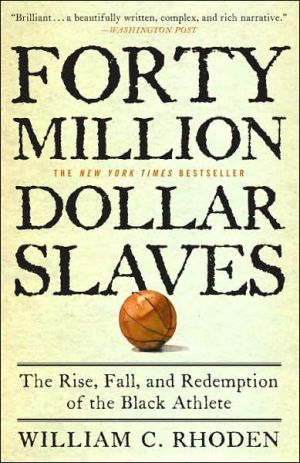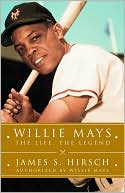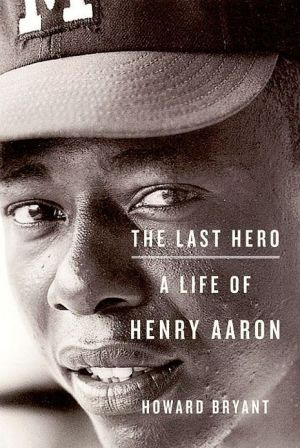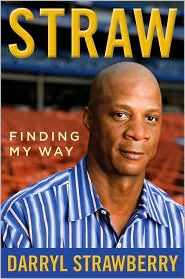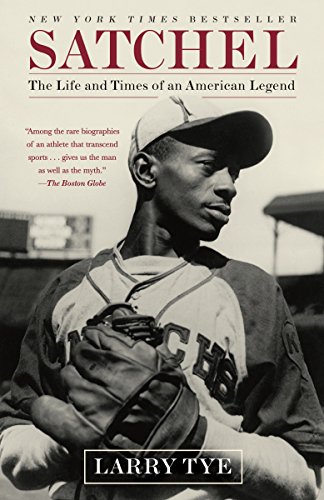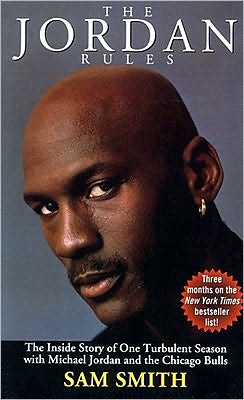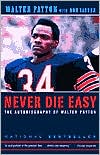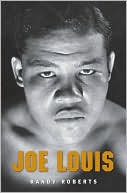Forty Million Dollar Slaves: The Rise, Fall, and Redemption of the Black Athlete
From Jackie Robinson to Muhammad Ali and Arthur Ashe, African American athletes have been at the center of modern culture, their on-the-field heroics admired and stratospheric earnings envied. But for all their money, fame, and achievement, says New York Times columnist William C. Rhoden, black athletes still find themselves on the periphery of true power in the multibillion-dollar industry their talent built.\ Provocative and controversial, Rhoden’s $40 Million Slaves weaves a compelling...
Search in google:
From Jackie Robinson to Muhammad Ali and Arthur Ashe, African American athletes have been at the center of modern culture, their on-the-field heroics admired and stratospheric earnings envied. But for all their money, fame, and achievement, says New York Times columnist William C. Rhoden, black athletes still find themselves on the periphery of true power in the multibillion-dollar industry their talent built. Provocative and controversial, Rhoden's Forty Million Dollar Slaves weaves a compelling narrative of black athletes in the United States, from the plantation to their beginnings in nineteenth-century boxing rings and at the first Kentucky Derby to the history-making accomplishments of notable figures such as Jesse Owens, Althea Gibson, and Willie Mays. Rhoden makes the cogent argument that black athletes' "evolution" has merely been a journey from literal plantations-where sports were introduced as diversions to quell revolutionary stirrings-to today's figurative ones, in the form of collegiate and professional sports programs. Weaving in his own experiences growing up on Chicago's South Side, playing college football for an all-black university, and his decades as a sportswriter, Rhoden contends that black athletes' exercise of true power is as limited today as when masters forced their slaves to race and fight. The primary difference is, today's shackles are often of their own making. Every advance made by black athletes, Rhoden explains, has been met with a knee-jerk backlash-one example being Major League Baseball's integration of the sport, which stripped the black-controlled Negro League of its talent and left it to founder. He details the "conveyor belt" that brings kids from inner cities and small towns to big-time programs, where they're cut off from their roots and exploited by team owners, sports agents, and the media. He also sets his sights on athletes like Michael Jordan, who he says have abdicated their responsibility to the community with an apathy that borders on treason. Sweeping and meticulously detailed, Forty Million Dollar Slaves is an eye-opening exploration of a metaphor we only thought we knew.The New York Times - Warren GoldsteinIn his provocative, passionate, important and disturbing book - part memoir, part history, part journalism - William C. Rhoden, a sports columnist for The New York Times, builds a historical framework that both accounts for the varieties of African-American athletic experience in the past and continues to explain them today.
Chapter 1\ The Race Begins: The Dilemma of Illusion\ Long before there was race and even before there was politics, there were Saturday mornings in the playground.\ Every summer, on Saturday mornings my father and I would greet the dawn. We’d have our breakfast, put on shorts and sneakers, walk across the street to the Martha Ruggles Elementary School playground, and practice basketball. My father was my first coach. He was a mathematics teacher by training, and his penchant for teaching extended to sports. He taught me how to catch a football and run a sprint. I played Biddy Basketball at the Chatham branch of the YMCA; my dad was the coach. An astute judge of talent, he recognized that his oldest son needed tutoring. And that’s how those joyous Saturday morning sessions evolved. I was eight years old, my shots barely reached the rim, but my dad constantly reminded me that there was a lot more to the game than shooting. He said that by the time I was able to hit the rim consistently, I’d have an idea of how to play the game. So we worked on fundamentals: dribbling, passing, catching. Now and then we’d play a game of one-on-one. He always won. For a change of pace, we’d run a foot race. He won that, too. But what I loved most about Saturday morning was the bonding. Those practice sessions gave me an opportunity to be with my father, and be with him on a relatively equal playing field. At every turn, I measured my physical prowess against my father’s. At every picnic, on every long walk, I’d challenge him to a race, keeping mental notes all along, noting how long he had to run hard before easing up and letting me win. He was still father, I was son, but I knew that one day, if I became strong enough, quick enough, big enough, competent enough, the dynamics of our athletic relationship would change.\ Those memories, carefully tucked away in my heart, are what make sports reverberate in my soul. Not covering the big games, interviewing celebrities and superstars, but childhood recollections of a boy trying to please his parents. The deepest, most ancient pull of sports for me has always been emotional. “Race” was something you did on the sidewalk or on a dusty road on the way home from school. In the beginning, speed and quickness didn’t have a color.\ My father tried to shield his three children from the brutality of the racial struggles that swirled about us in the 1950s. Every now and then he’d talk about some slight or indignity he’d suffered at the hands of a white person. Mostly he insulated us from the unfolding drama of the Civil Rights movement. Jackie Robinson desegregated Major League Baseball three years before I was born, but my father wasn’t much of a baseball fan, so I wasn’t shellacked in Jackie’s legend of black Americans in the United States.\ My mother was not an avid sports fan, but she was the lion in my soul. Her brother, my uncle Eddie, was a prizefighter in his younger days (my father called him the Canvas Kid). One day, when I complained about Billy Boy, our next-door neighbor, my mother didn’t advise me to turn the other cheek, or to ignore him, or to tell his mother. She essentially told me to go back and kick his ass. I remember the two of us standing in our kitchen, my mother giving me an impromptu boxing clinic. I can still hear her voice as she showed me how to throw a combination: “Bop, bop—just like that,” she said, showing me how to deck Billy Boy. I never did fight Billy Boy. I faced him in the yard soon after my mother’s tutorial but couldn’t bring myself to throw the first punch. This was my first lesson in combat: Power without heart and strategy is meaningless.\ My mother laid out the racial facts of life for me. She burst my bubble in our kitchen one afternoon when she said casually that there were more white people than black people in the United States. I was stunned. In my segregated world on Chicago’s South Side, black and brown were the dominant colors. In my world, white people were there, but they weren’t there. Invisible. The stores, the Laundromat, the record shops, my schools. If whites were the majority, where were they? Why didn’t I ever see any?\ Of course, the answers to these questions flowed into the larger ocean of segregation and racism. That, in turn, flowed back to the ritual my dad and I enacted when we watched sports.\ I learned about race and racism in front of the TV set. My father and I watched football games upstairs, in our bungalow on 78th and Calumet. We sat and cheered on the red leather seat my dad had pulled out of our ’56 Mercury station wagon. Televised football didn’t make a lot of sense to me back then. The images were too crowded, too small, too gray. The fun of it was cheering; and cheering interests were simple in our house. We rooted for the team with the most black players. We cheered for the hometown clubs, the Bears and White Sox, but aside from that, the general rule of thumb was that we cheered for the team with the most colorful presence.\ In those days, when black faces were few and far between, we cheered for the color of the skin. We had some variations to the general rule: If the team was from the South and had just one Brother, his team was our team; he was our man. Didn’t matter who the athlete was underneath his uniform or his skin—his true character was less significant than his presence. Out there on the field, he became the torchbearer for the race. Content of character mattered only to the extent that we prayed these pioneers wouldn’t embarrass The Race.\ The ritual my dad and I engaged in was one that took place among black sports fans and non-fans throughout the United States. The ritual went further back than Jackie Robinson, Joe Louis, or Jesse Owens. It probably went all the way back to the heavyweight prizefighter Jack Johnson in 1910, when the telegram runners passed through black neighborhoods calling out round-by-round progress of Johnson’s historic fight with Jim Jeffries, the first Great White Hope. When Johnson defeated Jeffries on July 4, 1910, black communities across the country exploded in celebration. Other parts of the nation exploded with violence. As news of Johnson’s victory spread, mobs of angry whites beat up and, in some instances, murdered blacks. Many whites feared that the black community might be emboldened by Johnson’s victory over a white man. And they were not mistaken. Those early symbolic victories were soul food.\ Symbolic representation was the rule of the day, part of a timeless ritual throughout the United States’ melting pot of ethnicity: Jews cheered for Jews, Irish for Irish, Italians for Italians. But the predicament of black Americans was more complex, precarious, and sometimes seemed even hopeless. African Americans were so disconnected from the American dream that sports often seemed the only venue where the battle for self-respect could be vigorously waged.\ My parents and their parents sat around their radios listening to Joe Louis fights, living and dying with every punch. Louis was fighting for himself and his country, but he was also fighting for a black nation within a nation. Every time Jackie Robinson went to bat, he did so for that elusive, ever-evolving state of mind called “Black America.”\ In those days of suffocating, uncompromising segregation, we cheered black muscle with a vengeance. The fate of black civilization seemed to rest on every round, every at bat. “Knock his white ass out,” or “Outrun his white ass,” or “Block that white boy’s shot.”\ Or, worst of all: “You let that white boy beat you?”\ Each group has had its cross to bear, but although Jews and Italians and Irish and all the other mingling European races could look forward to assimilating, assimilation was practically impossible for African Americans. The indelible marking of skin color made it so.\ Early in the formation of the United States, blacks became the designated drivers of the Scapegoat Express. We were the “outside others.” The nation needed a permanent workforce and a permanent pariah. African Americans, by virtue of some seventeenth-century decree, got the job. No amount of education, no amount of wealth, could remove the stigma of race. The paradox and dilemma of virulent racism is that our exclusion became the basis of our unity. The next two hundred years of our existence were defined by reacting to racism.\ So our cheering assumed a deeper meaning: we were cheering for our very survival. Black athletes became our psychological armor, markers of our progress, tangible proof of our worth, evidence of our collective Soul. Our athletes threw punches we couldn’t throw, won races we couldn’t run. Any competition or public showing involving an African American was seen as a test for us all; the job of the athlete was to represent The Race. This was a heavy burden on one hand, but at the same time it represented a noble, time-worn responsibility. You always represented.\ Paul Robeson—All-American football player, activist, orator, singer, actor—never forgot his first day as a freshman football player at Rutgers when white teammates tried to kill him—and nearly succeeded. Robeson never forgot his father’s angry reaction when informed that his son was thinking about quitting the team—and Rutgers. His father told him that quitting was not an option, regardless of how trying conditions became. “When I was out on the football field or in the classroom or anywhere else, I was not there just on my own. I was the representative of a lot of Negro boys who wanted to play football and wanted to go to college, and as their representative, I had to show that I could take whatever was handed out.”\ The attitude exemplified by Robeson’s father was widely embraced by African Americans—the idea that we were each connected to a national black community by a common experience, a common condition, and a common cause was commonplace.\ Floyd Patterson was the first African American athlete I can personally remember who carried the burden of The Race into the ring. Patterson became heavyweight champion in 1956—the youngest ever at the time. Soft-spoken and self-effacing, Patterson was the perfect media story: a young, wayward black boy, transformed by a caring white patron—Cus D’Amato—into a champion. In June of 1959 he defended his title against Ingemar Johansson and was pummeled without mercy. Johansson knocked Patterson down seven times in three rounds, and to many of us it felt as if black folks had been knocked out. But Patterson came back and won the rematch in June 1960, becoming the first fighter ever to regain the heavyweight championship. This was one of those psychic victories for black America, all the sweeter because Patterson proved all his doubters wrong. But then things got complicated. Patterson’s next opponent was Charles “Sonny” Liston, an illiterate former convict with mob connections, whom the New York State Athletic Commission described thus: “A child of circumstances, without schooling and without direction or leadership, he has become the victim of those with whom he has surrounded himself.”\ The scholar Maurice Berube called Liston the “stereotypical nightmare of the bad nigger, the juvenile delinquent grown up.”\ That was the first time I was confronted with the new complexities of race brought on by the nascent Civil Rights movement. Liston was no Floyd Patterson. That is, he was not the model Civil Rights Negro, beloved by all, especially by whites. So here were two black men fighting for the championship. Liston was regarded as a pariah; Patterson was cast as the Good Black. Even John F. Kennedy, the President of the United States, weighed in, telling Patterson that he had to “beat that guy” because a Liston victory would not be in the best interests of the Negro image. The fight definitely was not in Patterson’s best interest. Liston pulverized Patterson in their first fight in September 1962, knocking him out in two minutes of the first round.\ Even Malcolm X, like Liston a threat to both white and the Civil Rights model, weighed in on the 1963 Liston-Patterson rematch, expressing the hope that Liston would “shake Patterson up.”\ That he did. Liston beat Patterson even worse in their 1963 rematch.\ Then along came Cassius Marcellus Clay.\ Clay triggered an odd transformation in the country, in my household, and within the African American community. Liston’s mob connections were one thing, but Clay’s connection to the Black Muslims frightened a lot of blacks and whites a whole lot more. He had been recruited into the Nation of Islam by none other than Malcolm X, the radical minister who spoke of whites as blue-eyed devils.\ Suddenly, big, bad Sonny Liston was redefined. He became reassuring to an older generation of blacks who liked the old heavyweight model Liston represented and were intimidated by Clay’s brashness and connection to the Nation of Islam. A conservative segment of the community was screaming, “Enough of this militant business. Enough of this talk of separation, of blue-eyed devils.” They hoped that Clay would be crushed, silenced, dashed to bits by the Bear. It didn’t happen. Ali, the radical, defeated Liston, the thug, to become heavyweight champion. Later he fought Patterson and humiliated him in defeat because the former champion refused to call Clay by his new name, Muhammad Ali. Those of us who were younger and beginning to develop a more militant racial consciousness were thrilled by Ali. We called any black person who refused to call him by his name Old Negroes, Uncle Toms, or the white man’s niggers.\ Ali became the first universal, seemingly omnipresent black man. He said things we only imagined saying, did things many of us had never conceived of doing. He shunned his slave name, Clay, for Ali; he refused to be inducted into the U.S. Army and risked everything, including the heavyweight championship, for principle. When Ali was stripped of his title, it was as if he were being whipped by the overseer, like those “bad nigga” slaves of old. Publicly. We were outraged at the injustice, but inspired by his courage and fearlessness, which were as strong outside the ring as they were within the four corners. Ali was my Jackie Robinson, the sports figure who transcended sport to become a true role model. His example gave many of us strength—black and white, rich and poor. For me, Ali brought home the concept of principle, that there was something greater in life than wealth, though wealth has its place; something greater in life than fame, though fame has its place. And he taught me that in the right hands, wealth and fame, the fruits of athletic success, could be used as a tool in the ongoing struggle.
Ch. 1The race begins : the dilemma of illusion11Ch. 2The plantation : the dilemma of physical bondage35Ch. 3The jockey syndrome : the dilemma of exclusion63Ch. 4The Negro leagues : the dilemma of myopia99Ch. 5Integration : the dilemma of inclusion without power127Ch. 6Style : the dilemma of appropriation147Ch. 7The conveyor belt : the dilemma of alienation171Ch. 8The River Jordan : the dilemma of neutrality197Ch. 9Ain't I a woman? : the dilemma of the double burden219Ch. 10The $40 million slave : the dilemma of wealth without control231Ch. 11The one who got away? : the dilemma of ownership247
\ David LeonardForty Million Dollar Slaves is a beautifully written, complex and rich narrative. Rhoden offers a wonderful balance between the often-forgotten histories of great black athletes, such as bicyclist Major Taylor, Negro League entrepreneur Rube Foster and college football great Sam Cunningham, and nuanced social commentaries on the commercial exploitation of blackness, white control of the sporting world, and the devastating effects of integration on the Negro Leagues and the sports teams at historically black colleges and universities.\ — The Washington Post\ \ \ \ \ Warren GoldsteinIn his provocative, passionate, important and disturbing book - part memoir, part history, part journalism - William C. Rhoden, a sports columnist for The New York Times, builds a historical framework that both accounts for the varieties of African-American athletic experience in the past and continues to explain them today.\ — The New York Times\ \ \ Publishers WeeklyNew York Times columnist Rhoden offers a charged assessment of the state of black athletes in America, using the pervasive metaphor of the plantation to describe a modern sports industry defined by white ownership and black labor. The title and the notion behind it are sure to raise eyebrows, and Rhoden admits that his original title of Lost Tribe Wandering, for all its symbolic elegance, lacked punch. And Rhoden isn't pulling any of his. Rather than seeing rags-to-riches stories where underprivileged athletes reach the Promised Land by way of their skills, he casts the system as one in which those athletes are isolated from their backgrounds, used to maximize profit and instilled with a mindset "whereby money does not necessarily alter one's status as `slave,' as long as the `owner' is the one who controls the rules that allow that money to be made." Rhoden's writing is intelligent and cogent, and his book's tone is hardly as inflammatory as its name. It's possible that his title and working metaphor will turn off readers who will simply refuse to consider young men making millions of dollars playing a game to be disenfranchised. Nevertheless, this is an insightful look at the role of blacks in sports they dominate but hardly control. (June) Copyright 2006 Reed Business Information.\ \ \ \ \ Library JournalNew York Times sports columnist Rhoden explores the barriers some of the nation's greatest sports figures have faced because of their skin color. He discusses the expected luminaries-e.g., boxer Muhammad Ali, baseballer Jackie Robinson, and basketball legend Wilt Chamberlain. But equally interesting are his accounts of less well-known athletes, including jockey Isaac Murphy and cyclist Major Taylor. Most significant of all are Rhoden's often biting analyses, including his declaration that turn-of-the-20th-century America possessed a "deep-rooted fear of the fair fight" where African Americans were involved. Similarly, Rhoden writes that, to their racial brethren, black athletes served as "psychological armor, markers of our progress, tangible proof of our worth." He applauds the tradition of black athletes employing their celebrity to champion causes in the fashion of Paul Robeson, Jim Brown, and Curt Flood but is less pleased with the contemporary black star's abdication of responsibility to the black community. This sometimes riveting, often opinionated account is highly recommended for general libraries.-Robert C. Cottrell, California State Univ., Chico Copyright 2006 Reed Business Information.\ \ \ \ \ School Library JournalAdult/High School-Rhoden's provocative thesis is that today's black athletes are akin to pre-Civil War plantation slaves, because slavery had as much to do with power and control as it had to do with wealth. The big-money sports in America-football, baseball, basketball-are owned and controlled almost exclusively by white men, and yet each has a disproportionately large percentage of black athletes. They are well paid, but they have no direct power over the current and future direction of these sports. More than that, they lack any real control over their roles within these sports. The author supports his position with a well-researched and thoughtfully rendered survey of the history of the black athlete. From plantation-born jockeys and boxers of the early 19th century, to the NBA of Michael Jordan and Larry Johnson, Rhoden remains focused on prevailing structures of racism. He notes the accomplishments and frustrations of several well-known figures, including Jackie Robinson, Muhammad Ali, Jesse Owens, and Willie Mays, as well as others who have faded from our collective memory. In doing so, he examines the damaging effects of what he calls the "conveyor belt" in the contemporary sports world, where children as young as 11 and 12 are pegged as "prospects" and viewed as potential sources of income through middle school, high school, and college. This book will no doubt spark controversy, but will also prove to be a lasting contribution to the history of race relations in America.-Robert Saunderson, Berkeley Public Library, CA Copyright 2006 Reed Business Information.\ \ \ \ \ Kirkus ReviewsNew York Times sports columnist Rhoden explores the history of African-American athletes, decrying the unwillingness of modern players to take the courageous stands that characterized their predecessors. In many American sports, black faces are by far the most prevalent. This omnipresence and a few outrageous salaries, the author argues, have blinded society to the fact that black athletes remain subservient to white masters on the metaphorical plantation of sports. Beginning with slave-turned-prize-fighter Tom Molineaux in the early 1800s, African-American athletes have struggled to put themselves on equal footing with their white counterparts. Despite the skill and accomplishments of trailblazers like Molineaux and Jack Johnson, a lack of unity led to their exclusion from the sports they once dominated, such as horseracing and cycling, and duped them into supplying "black muscle" to build the business empires of white owners. Black style and flair unquestionably contributed heavily to the growth of sports in America, and Rhoden's arguments are compelling, as when, for example, he contends that the nonchalant brashness of Willie Mays and others like him was the foundation of the urban image that Madison Avenue once feared but has since co-opted in order to reap an economic windfall. His juxtaposition of stands taken by athletes like Curt Flood, whose sacrifices paved the way for free agency, with the meekness of corporate shills like Michael Jordan, is particularly effective. Rhoden's argument falters somewhat when he implies that racism, not money, is the motivating factor behind such developments as the globalization of the NBA, and when he fails to acknowledge that blacks are not theonly minorities who must contend with prejudice. While it's understandable that he focuses on the selfish, apolitical attitudes of superstar athletes, the author virtually ignores the contributions of hundreds, if not thousands, of lesser-known black athletes who invest their time, money and effort in strengthening the often poor urban communities from which they came. Provocative and distressing-just the right combination for beginning an important conversation.\ \
